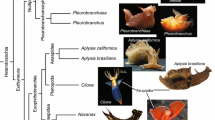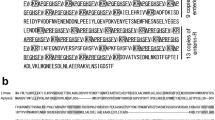Abstract
The pteropod mollusc Clione limacina is a highly specialized carnivore which feeds on shelled pteropods and uses, for their capture, three pairs of oral appendages, called buccal cones. Contact with the prey induces rapid eversion of buccal cones, which then become tentacle-like and grasp the shell of the prey. In the previous paper, a large group of electrically coupled, normally silent cells (A motoneurons) has been described in the cerebral ganglia of Clione. Activation of A neurons induces opening of oral skin folds and extrusion of the buccal cones. The present study continues the analysis of the electrical properties of A motoneurons.
Brief intracellular stimulation of an A neuron can produce prolonged firing (afterdischarge), lasting up to 40 s, in the entire population of A neurons. Afterdischarge activity is based on an afterdepolarization evoked by an initial strong burst of A neuron spikes. The data suggest that this afterdepolarization represents excitatory synaptic input from unidentified neurons which in turn receive excitatory inputs from A neurons, thus organizing positive feedback. The main functional role of this positive feedback is the spread and synchronization of spike activity among all A neurons in the population. In addition, it serves to transform a brief excitatory input to A neurons into their prolonged and stable firing, which is required during certain phases of feeding behavior in Clione.
Similar content being viewed by others
References
Adams DJ, Smith SJ, Thompson SH (1980) Ionic currents in molluscan soma. In: Cowan WM, Hall ZW, Kandel ER (eds) Annual review of neuroscience. Annual Reviews Inc., Palo Alto California 3:141–167
Benjamin PR (1978) Endogenous and synaptic factors affecting the bursting of double spiking molluscan neurosecretory neurones. In: Chalazonitis N, Boisson M (eds) Abnormal neuronal discharges. Raven Press, New York, pp 205–216
Benjamin PR, Rose RM (1984) Electrotonic coupling and afterdischarges in the Light Green Cells: a comparison with two other cerebral ganglia neurosecretory cell types in the pond snail, Lymnaea stagnalis. Comp Biochem Physiol 77A:67–74
Brown RO, Mayeri E (1989) Positive feedback by autoexcitatory neuropeptides in neuroendocrine bag cells of Aplysia. J Neurosci 9:1443–1451
Bulloch AGM, Willows AOD (1981) Physiological basis of feeding behavior in Tritonia diomedea. III. Role of depolarizing afterpotentials. J Neurobiol 12:515–532
Burmistrov YuM (1965) Circulation of nerve impulse in the system of lateral giant axons of river crayfish. Biophysica 10:90–97 (in Russian)
Calvin WH (1974) Three modes of repetitive firing and the role of threshold time course between spikes. Brain Res 69:341–346
Carew TJ, Kandel ER (1976) Two functional effects of decreased conductance EPSP's: synaptic augmentation and increased electrotonic coupling. Science 192:150–153
Cleary LJ, Byrne JH (1985) Interneurons contributing to the mediation and modulation of the tail withdrawal reflex in Aplysia. Soc Neurosci Abst 11:642
Frost WN, Wu LG, Lieb J (1991) Simulation of the Aplysia siphon withdrawal reflex circuit: slow components of interneuronal synapses contribute to the mediation of reflex duration. Soc Neurosci Abstr 17:1390
Getting PA, Willows AOD (1974) Modification of neuron properties by electrotonic synapses. II. Burst formation by electrotonic synapses. J Neurophysiol 37:858–868
Gola M (1976) Electrical properties of bursting pacemaker neurons. In: Salanki J (ed) Neurobiology of Invertebrates. Plenum, New York, pp 381–423
Gorman ALF, Hermann A, Thomas MV (1980) The neuronal pacemaker cycle. In: Koester J, Byrne J (eds) Molluscan nerve cells: from biophysics to behaviour. Cold Spring Harbor Lab 1:169–180
Hermans CO, Satterlie RA (1992) Fast-strike feeding behavior in a pteropod mollusc, Clione limacina Phipps. Biol Bull 182:1–7
Kandel ER, Spencer WA (1961) Electrophysiology of hippocampal neurons. II. Afterpotentials and repetitive firing. J Neurophysiol 24:243–259
Kaneko CRS, Merickel M, Kater SB (1978) Centrally programmed feeding in Helisoma: identification and characteristics of an electrically coupled premotor neuron network. Brain Res 146:1–21
Kiehn O (1991) Plateau potentials and active integration in the “final common pathway” for motor behaviour. Trends Neurosci 14:68–73
Kusano K, Grundfest H (1965) Circus reexcitation as a cause of repetitive activity in crayfish lateral giant axons. J Cell Comp Physiol 65:325–336
Lalli CM, Gilmer RW (1989) Pelagic snails. The biology of holoplanktonic gastropod mollusks. Stanford Univ Press, Stanford 259 pp
Litvinova NM, Orlovsky GN (1985) Feeding behaviour of pteropod mollusc Clione limacina. Bull Soc Nat Moscow, Sect Biol 90:73–77 (in Russian)
Maat A ter, Geraerts WPM, Jansen RF, Bos NPA (1988) Chemically mediated positive feedback generates long-lasting afterdischarge in a molluscan neuroendocrine system. Brain Res 438:77–82
Manteufel BP (1937) On the biology of Clione limacina Phipps. Bull Soc Nat Moscow, Sect Biol 46:25–35 (in Russian)
Norekian TP, Satterlie RA (1993) Cerebral neurons underlying prey capture movements in the pteropod mollusc, Clione limacina. I. Physiology, morphology. J Comp Physiol A 172:153–169
Smith TG (1980) Ionic conductances in bursting pacemaker cells and their hormonal modulation. In: Koester J, Byrne J (eds) Molluscan nerve cells: from biophysics to behavior. Cold Spring Harbor Lab 1:135–143
Spira ME, Bennett MVL (1972) Synaptic control of electrotonic coupling between neurons. Brain Res 37:294–300
Swigchem H van (1979) On the endogenous bursting properties of “Light Yellow” neurosecretory cells in the freshwater snail Lymnaea stagnalis. J Exp Biol 80:55–67
Thompson SH, Smith SJ (1976) Depolarizing afterpotentials and burst production in molluscan pacemaker neurons. J Neurophysiol 39:153–161
Wagner N (1885) Die Wirbellosen des Weissen Meeres: Zoologische Forschungen an der Küste des Solowetzkischen Meerbusens in den Sommermonaten der Jahre. Verlag Von Wilhelm Engelmann, Leipzig, 168 pp
Willows AOD (1980) Physiological basis of feeding behavior in Tritonia diomedea. II. Neuronal mechanisms. J Neurophysiol 44:849–861
Author information
Authors and Affiliations
Rights and permissions
About this article
Cite this article
Norekian, T.P. Cerebral neurons underlying prey capture movements in the pteropod mollusc, Clione limacina . J Comp Physiol A 172, 171–181 (1993). https://doi.org/10.1007/BF00189394
Accepted:
Issue Date:
DOI: https://doi.org/10.1007/BF00189394




